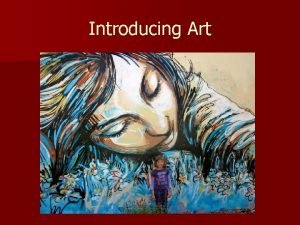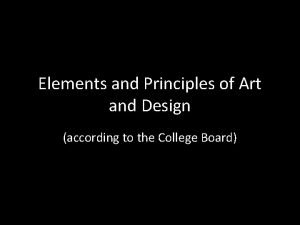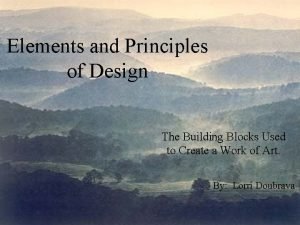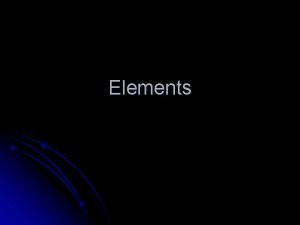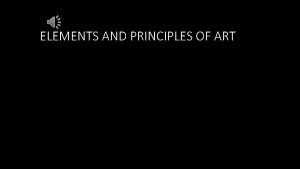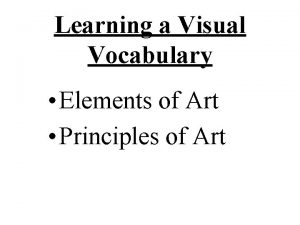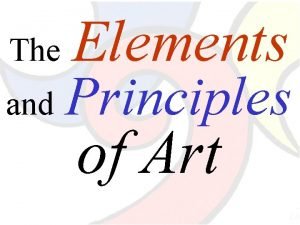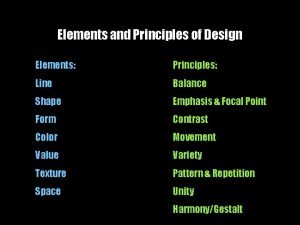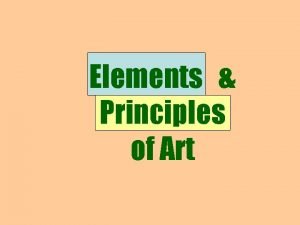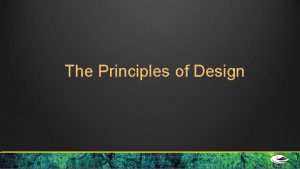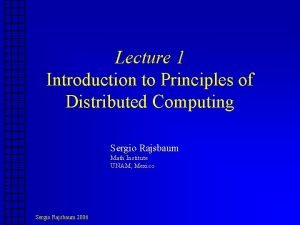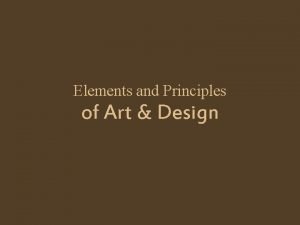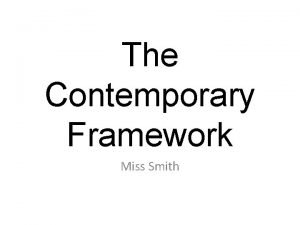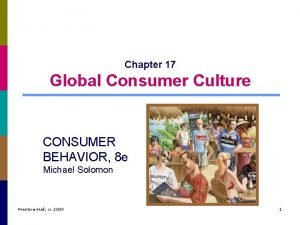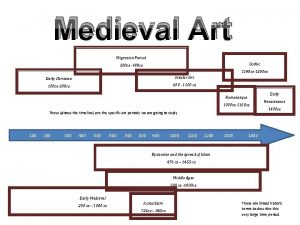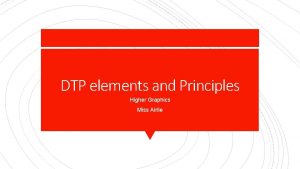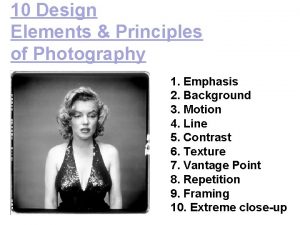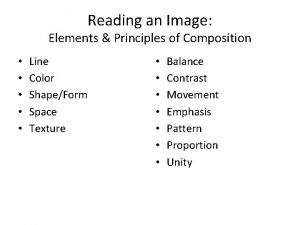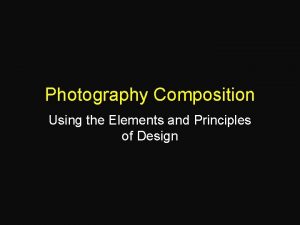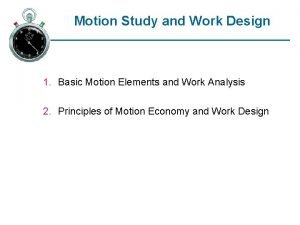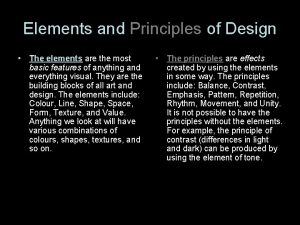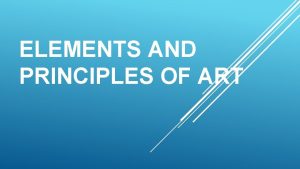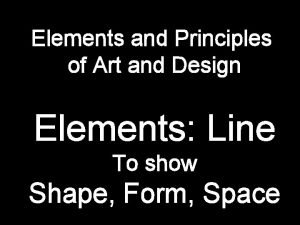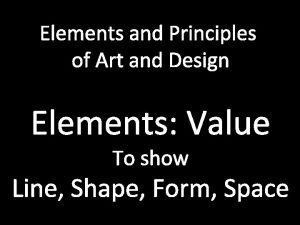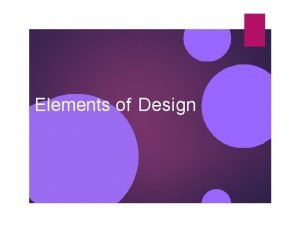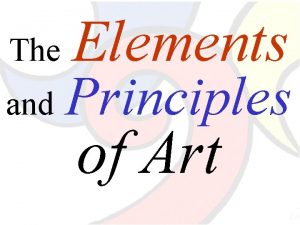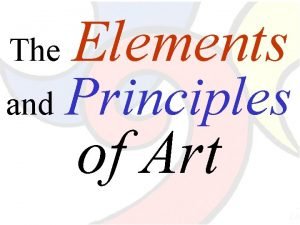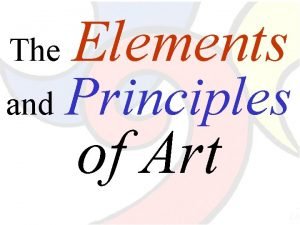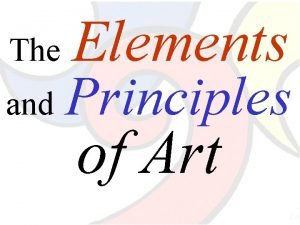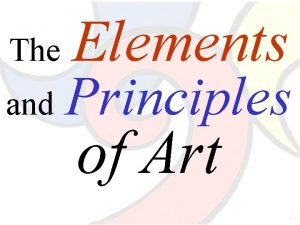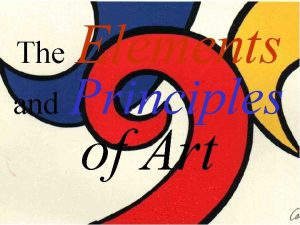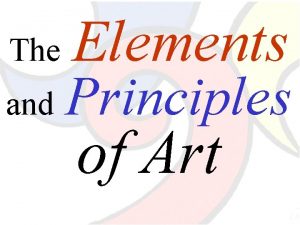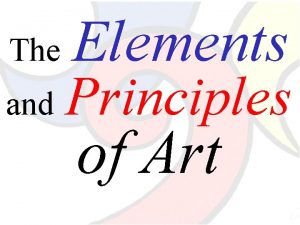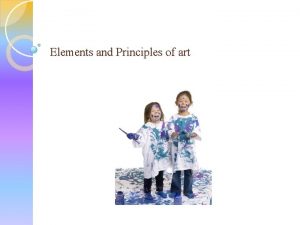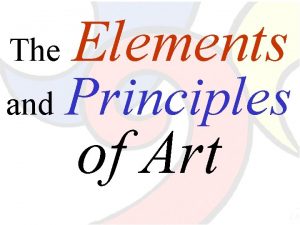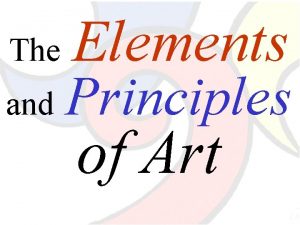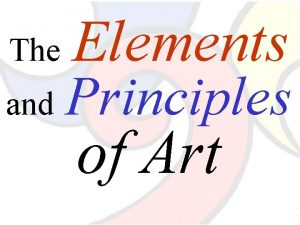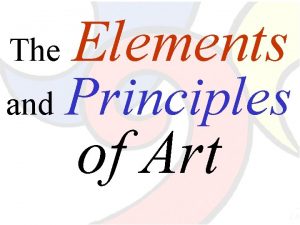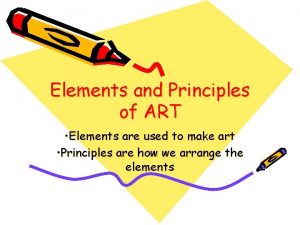Visual Computing Elements and Principles of Visual Art



































- Slides: 35

Visual Computing Elements and Principles of Visual Art

Elements and Principles of Visual Art ELEMENTS Line Shape/Form Space Value Texture Color PRINCIPLES Emphasis / Focal Point Balance Unity Contrast Movement / Rhythm Pattern / Repetition Symmetry / Asymmetry

Line Four Basic Types of Lines • A mark made by a moving point. • Has greater length than width. • Directs the eye – horizontal, vertical, diagonal, curvy, zig-zag, etc. • Can be actual obvious lines or the borders or edges of shapes.

Explicit Line Composition VIII, 1923, Wassily Kandinsky, The Solomon R. Guggebheim Museum, New York

Implied Line Venus at Her Mirror , Diego Velazquez, c. 1644 -48, Oil, 122. 5 x 177 cm National Gallery, London

Contour Line • Contour line is the line that distinguishes the outer edge of the object within the art work. The Mourning of Christ, Giotto, c. 1305, Fresco Cappella dell'Arena, Padua

Shape / Form • A contained area. • Can be GEOMETRIC (man-made) ex. Square, triangle, circle, etc. • Can be ORGANIC (natural) ex. Leaves, humans, puddles, etc. • Shapes are 2 -Dimensional and flat. (circle) • Forms are 3 -Dimensional with height, width and depth. (sphere) • Used to create a sense of space and substance.

Space The area used or unused in a composition. • Open and Closed – Open: A viewer’s eyes are led off the canvas – Closed: A viewer’s eyes are kept within the center of the canvas - all the characters and action are within the edges of the frame. • Positive and Negative – Positive: occupied space – Negative: empty space

Open and Closed Space Bassano’s work exhibits and open frame, the action leads the eyes all over the canvas and off the edges of the frame. van Eyck’s work exhibits a closed frame, the action is centered and the viewer is focused on the main action. The Way to Calvary, c. 1544 -5, Jacopo Bassano, National Gallery, London The Arnolfini Portrait, 1434, Jan van Eyck, National Gallery, London

Positive and Negative… ? Héraklès archer, 1909, Emile Antoine Bourdelle, Metropolitan Museum of Art, NY

Giorgio Morandi (Italian, 1890– 1964) Still Life (Natura morta), 1961 Oil on canvas; 9 7/8 x 11 7/8 in. (25 x 30 cm) Museo Morandi, Bologna Giorgio Morandi (Italian, 1890– 1964) Still Life (Natura morta), 1962 Watercolor on paper; 6 1/4 x 8 1/4 in. (16 x 21 cm) Museo Morandi, Bologna

Texture • The surface quality. • How an object feels, or how it looks like it feels. • Rough, smooth, bumpy, gooey, sharp, etc. Detail White Flag, 1955, Jasper Johns , Encaustic, oil, newsprint, and charcoal on canvas The Metropolitan Museum of Art , NY

Value • Black thru White • Dark to Light • Adds drama and impact to composition • Gives a sense of timelessness Odalisque in Grisaille, c. 1824– 34, Jean-Auguste-Dominique Ingres and Workshop, Metropolitan Museum of Art, NY

Color Artistic term is HUE Pigments for sale at a market stall in Goa, India. • • • PALLETTE - range of hues. MONOCHROMATIC - use of all shades of one color from dark to light. POLYCHROMATIC – use of a variety of hues.

Intensity is the purity of a hue, and the force of a visual image Orange sky on Highway 35 Amy Landrum, 2003 More Felled Trees on Woldgate, 2008, David Hockney, oil on canvas, two panels, 60 x 96 in.

Tint and Shade

Primary Colors Theory: Mixing primary colors will create secondary colors Red, Yellow, Blue II, 1965, Ellsworth Kelly Mixing Light

Secondary Colors Spectral Sequence ROYGBIV Spectrum IV, 1967, Ellsworth Kelly, MOMA, NY Oil on canvas, thirteen panels, 9' 9" x 9' 9"

Complementary Colors Complimentary colors are directly opposite on the color wheel. Red and Green Blue and Orange Yellow and Purple

Pigments A pigment is a material that changes the color of reflected or transmitted light as the result of wavelengthselective absorption. http: //www. webexhibits. org/pigments/

Color Symbolism Color is often used to make a reference to something symbolic Colors mean different things in different cultures. The Annunciation, Fra Angelico, Cortona, Italy, 1433 -1434.

Principles of Art The different arrangements – or compositions - of the ELEMENTS of design to create more visually engaging images. – Emphasis / Focal Point – Balance (Symmetry / Asymmetry) – Unity / Variety – Contrast – Movement / Rhythm – Pattern/Repetition

Emphasis / Focal Point • Emphasis in a composition refers to developing points of interest to pull the viewer's eye to important parts of the body of the work. • The focal point of an image is the place where your eyes are drawn to first. – Usually the focal point will be highlighted or the most striking color in the work. – The focal point can also be reinforced by the implied lines guiding the viewer’s perspective.

Where are your eyes drawn to first? Next? Then? Where is the focal point of this image? The Conversion of St. Paul, Caravaggio

• Several focal points or focal areas – areas of emphasis within this image. • Artist highlights places over the entire space of the canvas to move the viewer’s eyes across the image. • The artist leads the viewer into a story by way of manipulating the visual language.

Pattern/Repetition • An element that occurs over and over again in a composition. • Can repeat the element in a consistent pattern. • Can repeat the element in a variation of the pattern. • Patterns happen when an element recurs or repeats throughout the art work. Patterns help establish the rhythm of the overall work. When an established pattern is broken, it can provide variety and/or dissonance for the audience.

Pattern/Repetition Pause, 1964, Bridget Riley, Emulsion on board 115. 5 x 116. Wall of Light Desert Night, 1999, Sean Scully, Oil on canvas; 108 x 132 in. , Modern Art Museum of Fort Worth,

Balance - Symmetry & Asymmetry A sense of stability in the body of work The Seine at Port-Villez, 1894, Claude-Oscar Monet, National Gallery, London A Bar at the Folies-Bergeres, 1881 -82, Edouard Manet, Courtauld Institute Galleries, London

Unity Everything fits together as a whole - harmony Samson and Delilah, c. 1609 -10, Peter Paul Rubens, National Gallery, London

Variety Use of different shapes, textures, colors and values in artwork Still Life with Drinking Vessels, 1649, Pieter Claesz, National Gallery, London

Contrast The opposites and differences in value within a work of art. Whistlejacket, c. 1762, George Stubbs, National Gallery, London Nocturne: Blue and Silver - Cremorne Lights, 1872, James Abbott Mc. Neill Whistler, Tate Britain

Rhythm Relationship between the recurring elements in a work of art. Poplars on the Epte, 1891, Claude-Oscar Monet. National Gallery, London Swifts: Paths of Movement + Dynamic Sequences, 1913, Giacomo Balla, MOMA, NY

Movement Directs a viewer’s eye throughout the picture plane. The Origin of the Milky Way, c. 1575, Jacopo Tintoretto, National Gallery, London

Linear Perspective Sets the point of view. Aka. one-point-perspective. Leads the eyes to a vanishing point within the image. The Annunciation, with Saint Emidius, 1486, Carlo Crivelli, National Gallery, London

Atmospheric Perspective Distant objects appear more blue Based on observation Gives the illusion of a great distance in the background of the image. The Garvagh Madonna c. 1509 -10, Raphael, National Gallery London
 Types of emphasis in art
Types of emphasis in art The relative thickness or thinness of a line is known as
The relative thickness or thinness of a line is known as Elements and principles of art
Elements and principles of art Progressive rhythm in art
Progressive rhythm in art Principles of art rhythm
Principles of art rhythm Elements of art and principles of design matrix
Elements of art and principles of design matrix Visual elements
Visual elements Analysis of painting
Analysis of painting 7 principles of art
7 principles of art Elements and principles design matrix
Elements and principles design matrix Visual elements and principles of design
Visual elements and principles of design Conventional computing and intelligent computing
Conventional computing and intelligent computing Elements principles of art
Elements principles of art Principles of art
Principles of art It is the visual equalization of the elements of art
It is the visual equalization of the elements of art Principles of distributed computing
Principles of distributed computing End user computing audit
End user computing audit Element and principles of art
Element and principles of art What is high art and low art
What is high art and low art Cultural formulae
Cultural formulae Insular art is art produced between 300 and 900 ce
Insular art is art produced between 300 and 900 ce Form in hair design
Form in hair design What are the elements of hair design
What are the elements of hair design Opposition floral design
Opposition floral design Principles and elements of design chart
Principles and elements of design chart Elements of interior design ppt
Elements of interior design ppt Dtp elements and principles
Dtp elements and principles Design elements in photography
Design elements in photography Elements and principles of composition
Elements and principles of composition Principles of photography
Principles of photography Basic elemental motions that make up a job
Basic elemental motions that make up a job Elements and principles of design fashion
Elements and principles of design fashion Elements and principles of hybridity
Elements and principles of hybridity Design elements and principles of the universe
Design elements and principles of the universe Value and focus in art
Value and focus in art Elements and principles of architecture
Elements and principles of architecture
